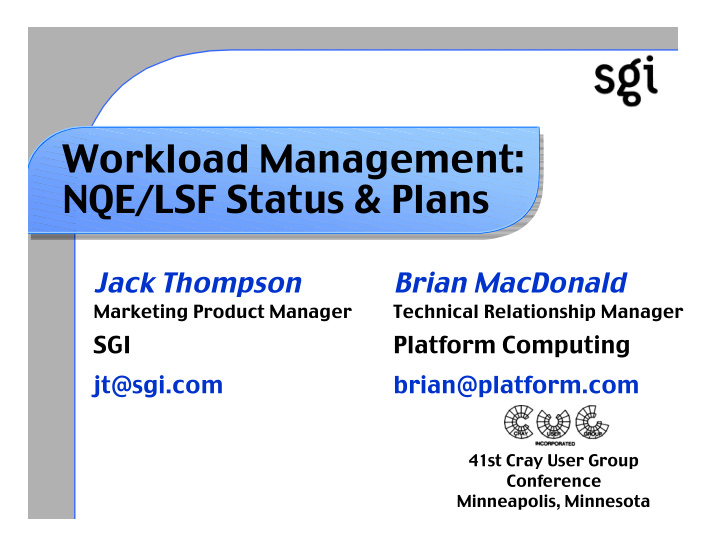



Workload Management: NQE/LSF Status & Plans Jack Thompson Brian MacDonald Marketing Product Manager Technical Relationship Manager SGI Platform Computing jt@sgi.com brian@platform.com 41st Cray User Group Conference Minneapolis, Minnesota
Agenda ¥ NQE Transition & Status ¥ Migration Program ¥ Status of LSF on SGI and Cray Systems ¥ LSF Plans ¥ Q&A 2
NQE Transition NQE 3.3 ¥ Final feature release Next Steps ¥ ISV solutions prevalent Ð Core competency issue Ð Multi-vendor environment ¥ Partner solution best choice ¥ Platform ComputingÕs LSF 3
NQE Status ¥ Supported on SGI and Cray Systems Ð Support through year-end, 2004 Ð Critical bugs fixed Ð Call center support ¥ Available for Cray SV1 systems ¥ Retired on non-SGI systems 4
LSF Migration Program ¥ Discounted pricing for systems licensed for NQE before February 1, 1999 Ð Available through January 31, 2000 ¥ Migration Guide Ð Developed jointly by Platform and SGI ¥ Professional services available ¥ Inclusion of key NQE features in LSF Strong relationship between SGI and Platform Computing engineering teams 5
LSF on SGI Systems Current release is LSF 3.2 ¥ Now available on IRIX, UNICOS, UNICOS/mk Ð Including Cray SV1 ¥ Also on NT and Linux ¥ Available from SGI Ð LSF Standard Edition, LSF Parallel, LSF Client ¥ Available from Platform Computing Ð LSF Analyzer, LSF MultiCluster, LSF JobScheduler, LSF Make 6
Data Center Requirements Environments for High Performance Ð Single point of control and administration Ð Logically present a single system image to users, applications and networks Ð Application of policies across the consolidated platform - uniform across all machines Ð Uniform policies to satisfy workload performance objectives in terms of throughput, turn around and response time Ð Improved application availability - both for failures and planned outages 7
Defining Capacity Goals LSF can be focused on throughput guarantees ¥ Run as much workload on the box, absolute performance not primary goal 8 CPUs 12 jobs, 900 MB 1 GB Memory of memory, lots 6 I/O Channels of disk activity or network disk access 8
Thresholds for Execution High Priority, Critical Workload Continues Critical and Stop Lower Acceptin Low Priority g New Priority Jobs Jobs Jobs Suspended or 85 % 90 % Migrated 100 % CPU Utilization 9
Defining Capability Computing Clearly Stated Performance Goals ¥ Get my job done as quickly as possible using all necessary dedicated resources ¥ Avoid sharing and contention at all costs ¥ Problems can be tackled that otherwise could not be considered ¥ Mission critical applications gain the undivided attention of the computing infrastructure 0
Defining Capability Computing Supporting the Exclusive Execution Model ¥ multi-box parallelism (Origin 2000) ¥ mixed operation large machines ¥ optimum support for Cray T3E ¥ committed product development in support of partitioning mechanisms Ð Miser (Q4 99) Ð Miser CPU sets (Q4 99) Ð OS service follow-on (XRS) 1
Resource Based Job Placement Selection Ð Match necessary conditions Ordering Ð Choose the best from eligible candidates Reservation Ð Adjust load values for selected hosts Spanning Ð Define locality of parallel jobs 2
Single Processing Image Resource Informatio LIM n . . . Scheduler submission hosts server hosts batch queues 3
System Level Integration ¥ placement ¥ SGI Array Session ¥ control (signals, limits, ¥ Task startup and message) control ¥ consolidated ¥ ASH returned to PAM accounting Parallel Application Manager ¥ MPT 1.3 Plug-in Remote Execution Server ¥ ASH sent to RES used to discover per job usage 4
Solutions Through Integration ISVs, Custom Scientific and Commercial Applications transparently gain access to resource management services without changing their code ¥ Application Checkpoint Restart ¥ Transparent host selection ¥ Accounting for ISV applications LSF Parallel 3.2 MPT 1.3 5
LSF 4.0 Enhancements Scheduler Ð Scalability improvements for all the bells and whistles turned on - Fair-share + Back-filling á 20,000 + jobs Ð Dynamic re-configuration without re-start á lim and mbatchd Ð Client query scalability á support for thousandÕs of clients Ð Adaptive dispatch for high throughput, short running jobs Ð Time dependent configuration for queues á different queue for night, same queue 6
LSF 4.0 Enhancements Job Execution Ð Improved Input/Output handling support á I/O Spooling á Admin defined spool directory á Job level CWD discovery enhancements Ð Integrated FTA supported within LSF Ð Job Flow Ð Kill re-queue Administrative Improvements Ð Non-shared daemon configuration support Ð Automatic host type and model detection 7
Recommend
More recommend